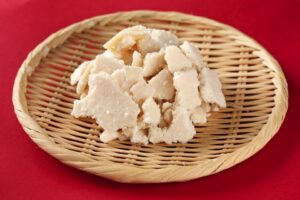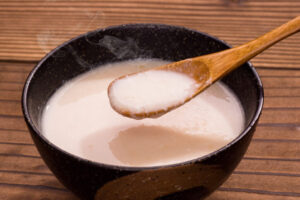Sakekasu refers to the by-product produced in the production process of sake.When making sake, sake Kasu are squeezed from fermented Moromi (Fermentation mash) , and the solid material left at that time is Sake Kasu.
Ingredients and ingredients of Sake Kasu
Sake Kasu are produced in the process of making sake, and are made by fermenting rice and koji, which are the ingredients of sake.Sake Kasu are rich in protein, dietary fiber, peptides, amino acids, vitamins, and other ingredients derived from rice, as well as metabolites produced by Aspergillus oryzae and yeast, and are said to have high nutritional value.
In addition to abundant nutrients, it also contains more than 100 kinds of enzymes produced by microorganisms during the manufacturing process.As it is a byproduct of squeezing sake, a unique characteristic it has is alcohol content left in the sake Kasu.
Production process of sake Kasu
Sake Kasu are produced by squeezing fermented Moromi.In order to understand sake Kasu more deeply, we will go more in depth of what Moromi is like.
What is “Moromi” which is the source of sake Kasu?
“Moromi”, which is the source of sake Kasu, is a muddy and cloudy liquid made from alcohol fermentation of the raw materials rice, rice koji, and water.By squeezing this mash, sake Kasu are divided into sake and sake Kasu, and sake Kasu are born for the first time there.
Sake Kasu can be made in the process of squeezing Moromi
In sake brewing, the process of squeezing the fermented Moromi into sake and sake Kasu is called “kamizo”.
The main method of the upper tank is to squeeze the Moromi by applying pressure with a press, but there is also a method called “bag hanging” in which the Moromi is put in a bag and hung, and it is squeezed only by gravity without applying pressure.There are also various upper tank methods such as centrifugation and freezing.
It is taken out by hand from the press
In the case of the upper tank using a press, the remaining sake Kasu in the machine are removed by hand.The total amount of sake Kasu collected at this time is measured and the ratio of the amount of sake Kasu and the amount of sake Kasu is derived.This percentage will be important data that will serve as a reference for sake brewing in the next generation.
Types of sake Kasu
Sake Kasu are classified into several categories, depending on the processed form, etc.Here, we will introduce the types of sake Kasu.

The taste of sake Kasu varies
I think there are many opportunities to see what is on the market as “Ginjo sake Kasu” and “Junmai sake Kasu”, but there are also “Honjozo sake Kasu” and “Daiginjo sake Kasu”.In short, sake Kasu exists as many types of sake as possible.The flavor of sake Kasu also changes depending on the ingredients and how it is made.
Classification by shape of sake Kasu
Sake Kasu are divided into several categories, depending on the shape they are sold.
Itakasu
It is a flat plate-shaped sake Kasu, and it is a product of the sake Kasu that became a plate when squeezing the Moromi and remained as it is.Because it is hard to dissolve, it is generally used to make it melt and paste before using or to lengthen the time to soak it in water.Itasaku is a unique way of enjoying itakasu that you can cut it into your favorite size and bake it as it is.
Rose Kasu
Sake Kasu in a state that can not be taken as itakasu and crumbled to pieces.Because it is finely crushed, it is softer than Itakasu and has the advantage of being easy to use.
Paste Kasu
Ita-Kasu and rose-Kasu are kneaded and processed into a soft paste.It is smooth and easy to melt, and it is also used as a seasoning, and it is also recommended to pickle vegetables and fish.
Merits of eating sake Kasu
If you check the food composition database (8th edition) created by the Ministry of Education, Culture, Sports, Science and Technology, it is classified into seasonings and spices category.
Some may think that because it is a byproduct and is classified in this way, there is not much left of nutrition, but there is an abundance of nutrients. I would not just call it one of the seasonings, but I would like to call it “perfect nutritional fermented food”.
Sake is mainly made from rice and water (Aspergillus and yeast), but if you compare the nutritional value of 100g of sake Kasu with the equivalent serving of white rice, the difference is obvious.
Compared to white rice, sake Kasu:
- 6 times higher than protein
- Dietary fiber 17 times
- 26 times higher than vitamin B2
- Vitamin B6 47 times
There are also numerous health benefits, and scientific studies have shown that sake Kasu are effective:
- Reduces the rise in cholesterol
- Lowering blood pressure
- Prevent Memory loss / Improve memory loss
- Suppression of liver damage
Thanks to the abundance of resistant proteins and fermentation enzymes, it also has a positive effect on the prevention of obesity and the improvement of metabolism.
Application of sake Kasu
Sake Kasu can be used in different ways, both in delicious food and in sweets.:
- Amazake (sweet low-alcohol drink while warm in winter)
- Soup and pot
- Marinade
- Pickling
- Bread and baked goods
- Ice cream or gelato

Sake Kasu naturally contains about 6-8% alcohol as a byproduct of sake brewing, so if you do not want to drink alcohol or give it to children, you should be careful to cook well and remove the alcohol content.
Apart from food, it is often used in beauty and cosmetics. It is rich in vitamin B2, known for beautifying the skin, and you can also make it yourself. It is also used as feed grain for animals, fertilizer for agriculture, and raw material for making shochu and gin.
As you can see, there are many benefits to sake Kasu, so please try using sake Kasu if you have the opportunity.
